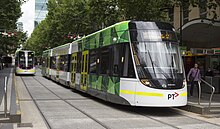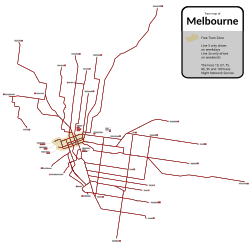
Back Straßenbahn Melbourne German Tramtransporto en Melburno Esperanto Tramway de Melbourne French Rete tranviaria di Melbourne Italian トラム (メルボルン) Japanese Red di tram de Melbourne LMO Melburno tramvajus Lithuanian Tramvaju satiksme Melburnā Latvian/Lettish Tram van Melbourne Dutch Sporvogn i Melbourne NN
| Melbourne tramway network | ||||||||||||||||||||||||||||||||||
|---|---|---|---|---|---|---|---|---|---|---|---|---|---|---|---|---|---|---|---|---|---|---|---|---|---|---|---|---|---|---|---|---|---|---|
| Public Transport Victoria | ||||||||||||||||||||||||||||||||||
 | ||||||||||||||||||||||||||||||||||
 E-class trams on Bourke Street in 2013 | ||||||||||||||||||||||||||||||||||
| Operation | ||||||||||||||||||||||||||||||||||
| Locale | Melbourne, Victoria, Australia | |||||||||||||||||||||||||||||||||
| Infrastructure | ||||||||||||||||||||||||||||||||||
| Track gauge | 1,435 mm (4 ft 8+1⁄2 in) standard gauge | |||||||||||||||||||||||||||||||||
| ||||||||||||||||||||||||||||||||||
| ||||||||||||||||||||||||||||||||||
| ||||||||||||||||||||||||||||||||||
The Melbourne tramway network is a tramway system serving the city of Melbourne, Victoria, Australia. The tramway network is centred around the Melbourne central business district (CBD) and consists of approximately 1,700 tram stops across 24 routes. It is the largest operational urban tram network in the world and one of the most used,[3] with more than 500 trams and 250 kilometres (160 miles) of double tram track. It served a patronage of 206 million over the year 2017-2018.[4][5][6] Trams are the second most utilised form of public transport in Melbourne after the city's metropolitan commuter railway network.[4]
Trams have operated continuously in Melbourne since 1885 (the horse tram line in Fairfield opened in 1884, but was at best an irregular service). Since then they have become a distinctive part of Melbourne's character and feature in tourism and travel advertising. Melbourne's cable tram system opened in 1885, and expanded to one of the largest in the world, with 75 kilometres (46.6 miles) of double track. The first electric tram line opened in 1889, but closed only a few years later in 1896. In 1906 electric tram systems were opened in St Kilda and Essendon, marking the start of continuous operation of Melbourne's electric trams.
Victoria's public transport system was reorganised in 1983 and saw the Melbourne & Metropolitan Tramways Board absorbed into the Metropolitan Transit Authority, which was in turn absorbed by the Public Transport Corporation in 1989. The network has been operated under contract since the commencement of franchising, following the privatisation of the Public Transport Corporation in 1999. The current private operator contracted to run Melbourne's tram system is Keolis Downer, trading as Yarra Trams.
Ticketing, public information and patronage promotion are undertaken by Victoria's public transport body, Public Transport Victoria. The multi-modal integrated ticketing system, myki, currently operates across the tram network.
At some Melbourne intersections (most within the CBD), motor vehicles turning right are required to perform a hook turn, a manoeuvre designed to give trams priority.[7] To further improve tram speeds on congested Melbourne streets, trams also have priority in road usage, with specially fitted traffic lights and exclusive lanes being provided either at all times or in peak times, as well as other measures.[8][9]
- ^ Joe Thompson. "Cable Tramways in Australia and New Zealand". The Cable Car Home Page. Archived from the original on 27 February 2021. Retrieved 16 December 2011.
- ^ David Hoadley (1998). "Trams Currently in Service". Trams of Australia. Archived from the original on 13 March 2018. Retrieved 16 December 2011.
- ^ "Facts & figures – Yarra Trams". yarratrams.com.au. Archived from the original on 26 February 2020. Retrieved 11 February 2019.
- ^ a b "Public Transport Victoria Annual Report 2017–18" (PDF). Public Transport Victoria. p. 12. Archived from the original (PDF) on 3 October 2018. Retrieved 3 October 2018.
- ^ "Facts & Figures". Yarra Trams. Archived from the original on 29 May 2014. Retrieved 13 October 2014.
- ^ "Facts & figures about Melbourne's tram network - Yarra Trams". yarratrams.com.au. Retrieved 6 February 2024.
- ^ "Turning". VicRoads. Archived from the original on 15 November 2011. Retrieved 10 October 2011.
- ^ "Think Tram Program". VicRoads. Archived from the original on 14 November 2011. Retrieved 19 October 2011.
- ^ "Tram priority & safety", VicRoads, archived from the original on 14 November 2011, retrieved 19 October 2011
© MMXXIII Rich X Search. We shall prevail. All rights reserved. Rich X Search

